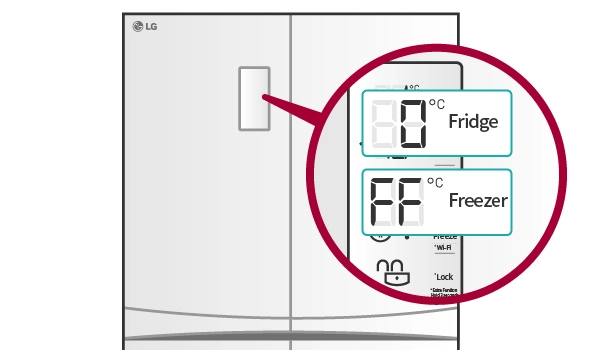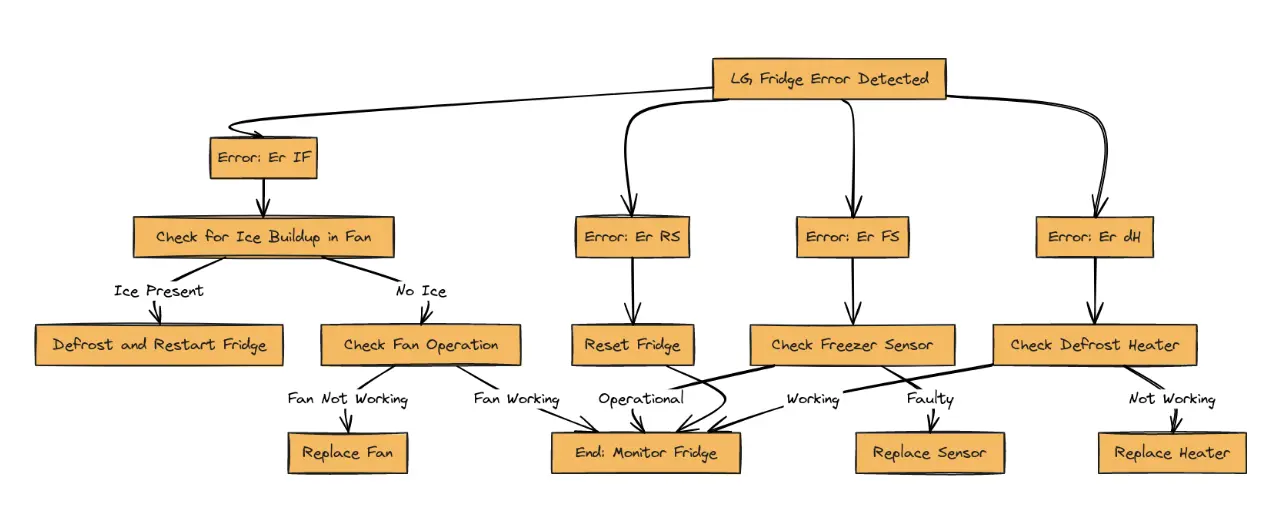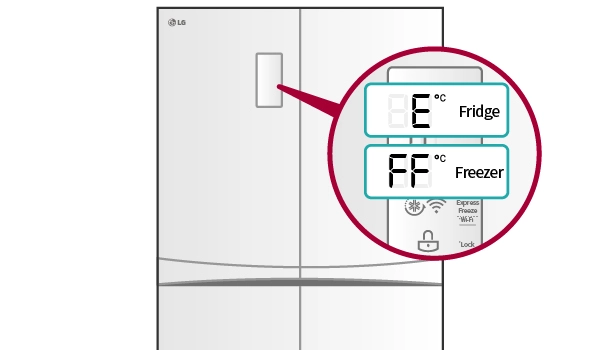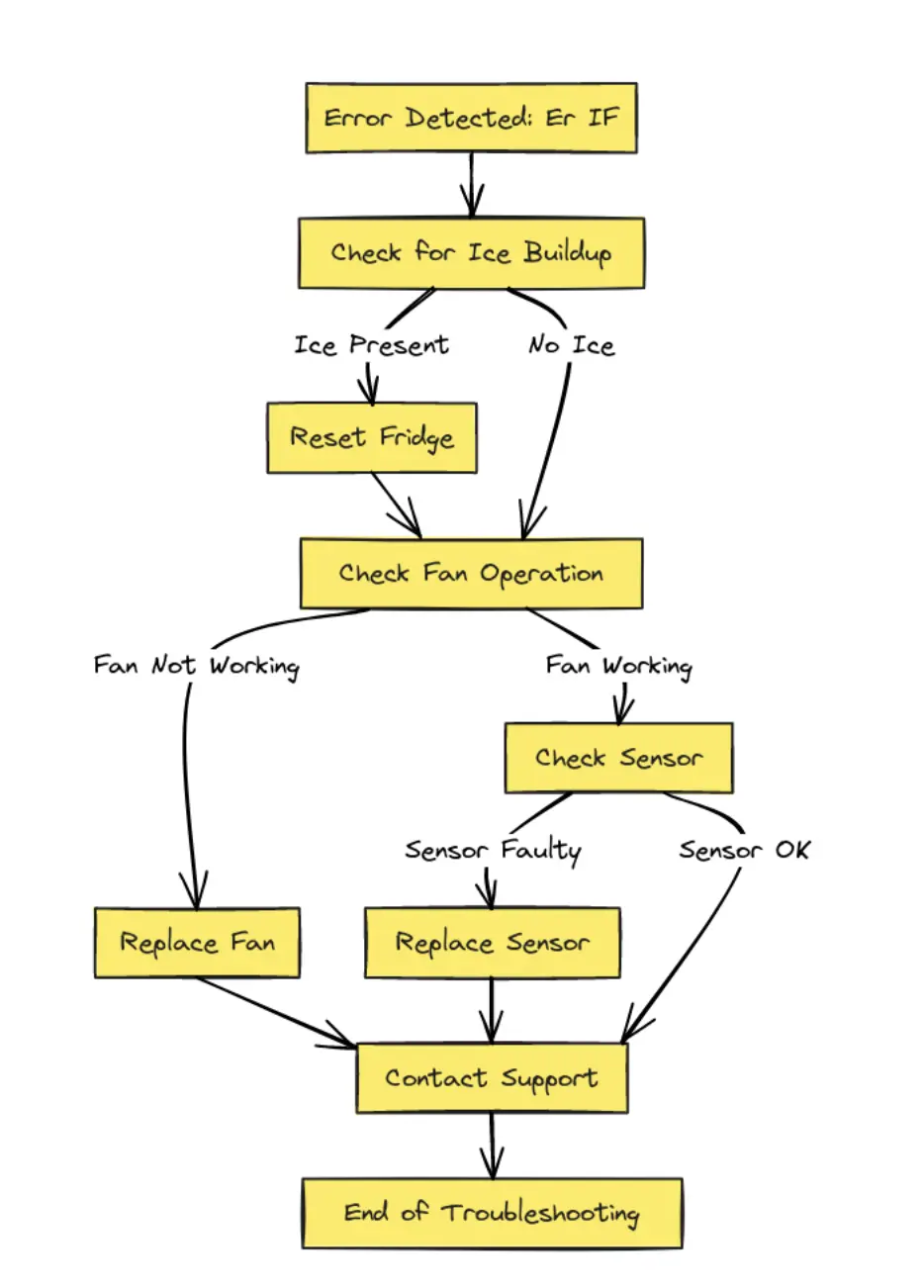Navigating those pesky LG refrigerator error codes can feel like trying to crack the DaVinci code, am I right? But don’t sweat it – our fresh guide is here to be your trusty translator.
We’re serving up all the deets on over 30 funky fridge codes, from those chill symbols to the heated error Messages.
Get ready to become a master decoder of your LG’s secret signals! Whether you’re facing a freaky freezer fiasco or a ridonkulous refrigerator riddle, we’ve got the 411 on the unique fixes and trends.
This isn’t your mama’s boring old manual – our guide is popping with that real human touch to make solving those code conundrums a total breeze.
Key Takeaways
- LG refrigerator error codes signal specific problems, ranging from minor issues like door closures to major malfunctions like compressor failures.
- Early diagnosis and fixes can prevent costly repairs and maintain appliance efficiency.
- Regular maintenance, such as cleaning coils and checking seals, can preempt many error codes.
- Professional help is crucial for persistent or serious issues, especially those involving electrical systems or refrigerant leaks.
Decoding 50 + LG Refrigerator Error Codes
| Code | Error Description |
|---|---|
| FS | Freezer sensor problem |
| rS | Refrigerator sensor issue |
| dS | Defrosting sensor malfunction |
| EID | Ice maker sensor failure |
| dH | Defrosting issue |
| FF | Freezer fan problem |
| F1 | Ice maker fan issue |
| C1 | Internal communication error |
| CO | Control panel problem |
| IS | Ice maker fan or sensor issue |
| rF | Refrigerator fan abnormality |
| gF | Water line problem |
| Sb | Sabbath mode |
| CL | Refrigerant leak |
| 22 | Compressor relay issue |
| 67 | Door or object restriction |
| 0d | Wi-Fi modem or communication error |
| c1 | Communication error between control board and dispenser |
| F dS | Freezer defrost sensor problem |
| r dS | Refrigerator defrost sensor issue |
| 9F | Flow sensor error or low water pressure |
| HS | Humidity sensor short or wiring problem |
| IF | Refrigerator ice maker sensor issue |
| r5 | Refrigerator sensor disconnection |
| rt | Room-temperature sensor shortened or open |
| SS | System error inside ice maker |
| CF | Feedback signal less than 65 seconds during fan operation |
| CH E | High side refrigerant leak |
| CL E | Low side refrigerant leak |
Why Error Codes Matter
First, understanding these codes is crucial because it helps you identify problems early.
Catching an issue early can mean the difference between a simple DIY fix and a costly repair down the line.
Plus, it keeps your food fresh, your drinks cold, and your ice cream from turning into soup!
How to Read the Signals
Each error code on your LG fridge has a specific meaning. They might indicate anything from a minor hiccup, like a door left ajar, to more serious issues requiring professional attention, such as a compressor problem.
Here’s a quick breakdown:
- OF F / 0F F tells you the fridge is in Demo Mode, perfect for showrooms but not for cooling your groceries.
- Er IF or Er FF might pop up if there’s something funky with the fan motor.
- F dH suggests a hiccup in the defrosting process.
- Are you seeing ECO? It’s hinting at a communication error between the fridge’s brains.
Tackling the Codes
When you encounter an error code, don’t panic. Some can be resolved with a simple reset — like turning your fridge off and on again.
Others, like ensuring the doors are properly closed, are just as straightforward. However, some codes are a bat signal for professional help.
I once had the Er IF code light up my fridge panel like a Christmas tree. It turned out to be a frosty fan needing a bit of defrosting.
Another common tale is the OF F code, easily mistaken for a major fault when it’s just the fridge showing off in Demo Mode.

Did you know that regular maintenance, like cleaning the coils and checking door seals, can prevent many of these codes from ever appearing? It’s like giving your fridge some TLC to keep it happy.
Understanding LG Refrigerator Error Codes

EFS: Defect of Freezer Sensor
- Why It Occurs: This pops up due to a short circuit or disconnection in the freezer sensor.
- Diagnosis & Troubleshooting: Check the sensor’s wiring and connections. If disconnected or damaged, reconnect or replace the sensor.
ErS: Defect of Refrigerator Sensor
- Why It Occurs: Similar to the EFS, this indicates issues with the fridge sensor.
- Diagnosis & Troubleshooting: Inspect for loose connections or breaks in the wiring, and ensure the sensor is properly connected.
ESS: Defect of Pantry Sensor
- Why It Occurs: Arises from a pantry sensor disconnection or short circuit.
- Diagnosis & Troubleshooting: Verify the pantry sensor’s wiring. Reconnect or replace if necessary.
EIS: Defect of Ice-Room Sensor
- Why It Occurs: Signals a disconnection or short in the ice-room sensor.
- Diagnosis & Troubleshooting: Examine the ice-room sensor’s connections, adjusting as needed.
FdS: Defect of Freezer Defrosting Sensor
- Why It Occurs: Indicates a short-circuit or disconnection in the defrosting sensor.
- Diagnosis & Troubleshooting: Check the defrosting sensor’s wiring and reconnect or replace it if found faulty.
Ert: Defect of Room Temperature Sensor
- Why It Occurs: Due to a disconnection or short-circuit in the room temperature sensor.
- Diagnosis & Troubleshooting: Ensure the sensor’s wiring is intact and properly connected.
EHS: Defect of Humidity Sensor
- Why It Occurs: Triggered by a disconnection or short in the humidity sensor.
- Diagnosis & Troubleshooting: Inspect the humidity sensor and its connections for any faults.
EId, EIO, EIt, EIU, EIC: Ice Maker Issues
- Why They Occur: These codes signal various issues with the ice maker sensors and motors.
- Diagnosis & Troubleshooting: For motor-related errors, check for ice blockages or mechanical failures. Sensor issues will require checking the connections and circuit continuity.
EgF: Defect of Flow Meter
- Why It Occurs: Indicates a malfunction due to lack of water supply or flow meter issues.
- Diagnosis & Troubleshooting: Ensure your water supply is on and inspect the flow meter for any blockages or mechanical faults.
FdH: Failed Defrosting
- Why It Occurs: When the defrosting sensor doesn’t reach the required temperature within 80 minutes.
- Diagnosis & Troubleshooting: This may involve resetting the defrost timer or replacing the sensor if it’s not functioning properly.
EFF: Abnormality of BLDC FAN Motor for Freezer

- Why It Occurs: If there’s no feedback signal from the fan motor for more than 65 seconds.
- Diagnosis & Troubleshooting: Check the fan motor for obstructions or damage. You might need to clean, repair, or replace the fan motor.
ECO & ESd – When your fridge’s main brain and its display aren’t talking properly.
- Why? Could be a glitch after a power surge or a loose connection.
- Diagnosis: Check connections and reboot your fridge by unplugging it for a minute.
- Solution: Reconnect any loose wires. If the issue persists, it might need a pro’s touch.
EOd – Your Wi-Fi modem inside the fridge isn’t connecting.
- Why? Often a sign of network issues or modem failure.
- Diagnosis: Ensure your home network is stable.
- Solution: Reset your router and fridge’s Wi-Fi settings. If no luck, the modem may need replacing.
ECH & ECL – Indicate refrigerant leakage, a serious cooling issue.
- Why? Damage or wear over time can lead to leaks.
- Diagnosis: Listen for unusual hissing sounds or check for frost where it shouldn’t be.
- Solution: This is a job for professionals due to the complexity of the refrigeration system.
rdS & EdS – Problems with your defrost sensor, leading to frost issues.
- Why? Could be a disconnection or sensor failure.
- Diagnosis: Manual check for frost build-up and sensor connectivity.
- Solution: Reset the fridge. Persistent issues mean replacing the sensor.
ErF – The refrigerator’s fan isn’t running as expected.
- Why? Frost buildup or motor failure.
- Diagnosis: Listen for the fan. Silence or stuttering is a bad sign.
- Solution: Defrost your fridge first. No change? The fan might need replacing.
EUC – UV Nano LED Module Error, impacting sterilization features.
- Why? Faulty module or connection issues.
- Diagnosis: Check for error messages related to the UV function.
- Solution: Ensure proper connection. If unresolved, the module may need service or replacement.
Elt, Ett, & ECS – From ice-maker unit errors to water tank and pantry sensor woes.
- Why? Mechanical failures or sensor malfunctions.
- Diagnosis: Inspect for obvious obstructions or disconnections.
- Solution: Resetting can help. If not, parts may need repair or replacement.
Ead – Auto Door Module Problem, affecting fancy fridge doors.
- Why? Sensor or motor issues.
- Diagnosis: Check door functionality.
- Solution: A reset might help, but it’s often a sign to call in a technician.
EAS & LAS/rAS – Auto Door/Drawer Reed Switch Problems
- Why Does This Occur? Problems with auto door/drawer reed switches usually stem from loose connections or misalignments.
- How to Diagnose: Check if the door or drawer aligns properly and listen for a click indicating the reed switch is engaging.
- Step-by-Step Solution:
- Inspect the connector for any visible damage or looseness.
- Realign the door/drawer if misaligned to ensure proper contact with the reed switch.
- Test the switch with a multimeter for continuity. Replace if defective.
EdL & Edr – Auto Drawer Module Problems
- Why Does This Occur? These issues often arise from faulty hall sensors, motors, or connections within the auto drawer module.
- How to Diagnose: Listen for unusual noises or check for unresponsive drawer movements.
- Step-by-Step Solution:
- Open the drawer and inspect the module for any disconnections or damage.
- Check the hall sensor and motor with a multimeter for proper function.
- Reconnect or replace parts as necessary.
EC1 & ErC1 – Communication Problems
- Why Does This Occur? These errors usually signal a breakdown in communication between the fridge’s main control board and its display components.
- How to Diagnose: Error messages or blank displays often indicate these issues.
- Step-by-Step Solution:
- Restart your refrigerator to reset the communication system.
- Inspect wiring harnesses for any signs of damage or lose connections.
- Consult a professional if the problem persists after a reset.
dSF, HSE, ISE – Sensor Errors
- Why Do These Occur? From freezer defrosting to humidity and icing sensors, errors usually indicate disconnections or shorts.
- How to Diagnose: An error code display along with unusual fridge behaviours, like over-frosting or temperature irregularities, signals these issues.
- Step-by-Step Solution:
- Locate the sensor based on your fridge model’s manual.
- Inspect the sensor and its connections for any signs of damage.
- Measure resistance or continuity with a multimeter and compare it to the standard values provided by LG.
- Replace the sensor if it falls outside of the normal range.
Pantry Sensor Error (SSE)
- Why does this occur? A short or disconnection of the pantry sensor.
- How to diagnose: Check for visible disconnections or damage to the sensor’s wiring.
- solution: Reconnect any loose wires or replace the sensor if damaged. It’s like reconnecting with a lost friend.
Room Temp Sensor Error (rtE)
- Why does this occur? Similar to SSE, due to a short or disconnection.
- How to diagnose: Inspect the sensor for disconnects or short circuits.
- solution: Secure any loose connections or swap out the sensor to ensure your fridge correctly reads the room’s mood.
Ice Maker Kit Defect (ItE)
- Why does this occur? Issues within the ice maker’s electrical system, such as the motor or Hall IC.
- How to diagnose: Listen for unusual noises or check for ice maker inactivity.
- solution: This one might require a professional’s touch, but starting with a reset of the ice maker can sometimes work wonders.
Freezer Defrosting Error (dHF)
- Why does this occur? The defrosting sensor doesn’t hit 46°F (8°C) within 80 minutes.
- How to diagnose: Monitor the defrost cycle for timing and temperature.
- solution: Manually defrost your freezer, then check if the sensor resumes normal operation. Sometimes, it just needs a little nudge.
Abnormality of BLDC FAN Motor for Freezer (FFE)

- Why does this occur? No feedback signal from the fan motor for over 65 seconds.
- How to diagnose: Listen for the fan — silence here is not golden.
- solution: Reset the fridge. If the fan’s still shy, it’s time to replace the motor or seek a technician’s help.
Abnormality of BLDC FAN Motor for Mechanic Room (CFE)
- Why does this occur? Same as FFE, a missing feedback signal from the fan motor.
- How to diagnose: A quiet mechanic room fan is a telltale sign.
- solution: After a reset, if the issue persists, replacing the fan motor might be your best bet.
Communication Error (COE)
- Why does this occur? Miscommunication between the main and display MICOMs.
- How to diagnose: When your fridge’s display starts acting like a moody teenager, not sharing info correctly.
- Solution: Start with a power cycle — unplug for a minute, then reconnect. Stubborn cases may require firmware updates or professional advice.
When to Contact a Professional
Sometimes, your LG refrigerator speaks in codes that are a bit too complex for the average Joe or Jane.
That’s when calling in the cavalry (aka professional repair services) isn’t just advisable, it’s necessary.
Understanding the Serious Signals
While some error codes are like minor colds your fridge can shake off with a bit of rest (or a reset), others are more like a fever that won’t break — a sign of something potentially serious. Here are signs it’s time to call a pro:
- Persistent Error Codes: If the same code reappears after you’ve tried the standard fix, it’s time to get professional eyes on the problem.
- Codes Indicating Major System Failures: Some codes, like those suggesting compressor issues or sealed system leaks (think ECH, ECL, or anything with a “compressor” in the explanation), require expertise beyond a DIY fix.
- Electrical Oddities: Any error code hinting at electrical problems, such as ECO or ESd, should have you reaching for the phone. Electrical issues can escalate if not handled correctly.
Why Expertise Matters
Professionals have the tools, training, and experience to diagnose and fix problems efficiently and safely. They can also identify underlying issues that aren’t immediately apparent. Remember, refrigerators are complex machines; what might seem like a minor annoyance could be symptomatic of a larger issue.
Real-Life Scenario
Imagine you’re dealing with an Er IF code — a fan issue. You’ve defrosted, you’ve reset, but the code persists. A professional might uncover a deeper problem, like a malfunctioning control board, saving you from a future fridge meltdown.
A survey found that over 50% of refrigerator repairs required a professional due to the complexity of the issues encountered. It’s a reminder that sometimes, we need to lean on expert knowledge.
Wrapping Up LG Refrigerator Error Codes
We’ve ventured through the beeps and blinks of LG Refrigerator Error Codes, unravelling their meanings like detectives on a culinary case.
These codes, far from being mere nuisances, are your fridge’s way of communicating, ensuring your kitchen’s heartbeat remains strong and steady.
Remember, understanding these codes isn’t just about fixing immediate problems; it’s about fostering a long-term relationship with your appliance.
Regular maintenance, like a gentle coil cleaning or a seal inspection, can ward off many issues before they even have a chance to beep their first distress signal.
Now, I turn to you, fellow fridge aficionados.
Don’t let those error codes mystify you or disrupt your daily routine.
Instead, let them be your guide to a well-maintained, efficient refrigerator that serves your family for years to come.
- Do you have an error code you can’t crack? Reach out to a professional.
- Curious about maintenance tips? Dive into the wealth of resources available online or consult your user manual.
- Have a story to share? We’d love to hear how you turned a frustrating error code into a victory against appliance adversity.
What’s your LG refrigerator story? Share it with us, and let’s keep the conversation (and our fridges) cool and running!